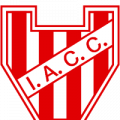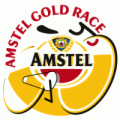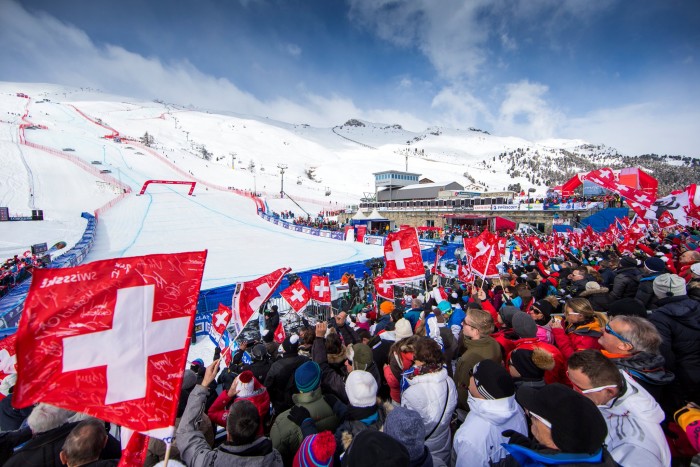The 2015-16 Alpine Skiing World Cup will conclude with the Finals this week in St. Moritz, the venue of next year’s World Championship. The World Cup Finals have a race in each discipline apart from alpine combined, as well as a mixed team competition. 25 best in each discipline’s World Cup standings and the junior World Champions are qualified to race in respective disciplines’ final races as well as those with over 500 overall points are qualified to race in all disciplines.
In the men’s World Cup, the downhill and super-G titles are still open in the final race whereas the giant slalom and slalom titles are already decided. Marcel Hirscher has practically secured his fifth consecutive overall World Cup title as his only potential title challenger Henrik Kristoffersen doesn’t race in speed disciplines.
Italy vs. Norway Battle for Downhill Title with A French Outsider
Thanks to his brilliant first half of the season, Aksel Lund Svindal is still leading the downhill World Cup standings despite suffering a season-ending knee injury in the Kitzbühel downhill in January and having missed the four downhill races since then. Yet most likely he will lose the lead in the final downhill of the season. He already is tied in points with Peter Fill who is ranked second because of his one win versus Svindal’s four.
Besides Fill, Italy has another title candidate; Dominik Paris is only four points behind Svindal and Fill. And while Norway is missing Svindal, they have another title contender, Kjetil Jansrud, 54 points from lead. Fifth man with a very slim title chance is the Frenchman Adrien Théaux, 66 points behind.
The following table shows how many points each skier would have in different result scenarios.
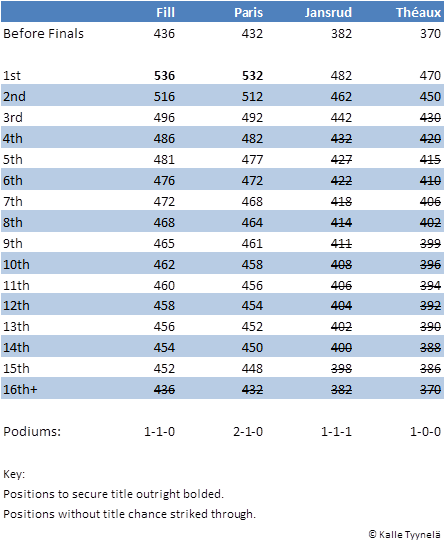
As we can see, winning the race is enough for the title for Fill or Paris (not enough for Paris if Fill tied for the win) but not for Jansrud or Théaux. The gap between Fill and Paris is so minimal that Fill can’t afford losing to Paris, as long as Paris is inside the top seven. Jansrud has two difficult title scenarios; the more realistic is winning the race, Paris missing the top three and Fill missing the top four, the less realistic is finishing second, Théaux not winning, Paris missing the top eight, and Fill missing the top 10. Théaux’s slim chance would require winning the race, Jansrud not tying for the win, Paris missing the top six, and Fill missing the top seven. Or alternatively he should finish in second place, Jansrud miss the top two, Paris miss the top 14, and Fill miss the top 15.

Paris seems like the favorite for the title, he has been the best skier of the last three downhill races with wins from the last two races of Chamonix and Kvitfjell and a second place in Jeongseon. Fill, on the other hand, has slightly struggled in the four races after his win in Kitzbühel, finishing them in 11th, fourth, fifth, and alarmingly 10th in the last race of Kvitfjell. Fill has made the podium only twice this season in downhill, the win in Kitzbühel and the second place in the season-first downhill of Lake Louise. Given Paris’s great form, Fill would badly need to return to podium in St. Moritz, and even then he would need to beat his red-hot countryman for the title.
The defending champion Jansrud comes into the final race in a different position than last year when he was defending the lead, now he’s the chaser who can only try to do his best and see what Fill and Paris will do. Yet also last year in Méribel he was in a must-win situation to be safe for the title, handling the pressure well and secured the title with a race win. He is surely a dangerous title contender but it is not in his hands, Fill and Paris just need to finish high enough compared to the Norwegian.
Théaux’s title chance seems only mathematical but anything is possible. In rough conditions in Santa Caterina where Théaux achieved his only win of the season, his title rivals finished so low that with a repeat of that race Théaux would win the title, even by finishing in second place. Yet that is a very unlikely scenario; the win in Santa Caterina is Théaux’s only top-two result of the season, the requirement for him in St. Moritz to have a title chance.
In that light, even Svindal might have a better chance to end the season on top of the standings. As only the top 15 are awarded points, Fill and Paris need at least a 15th place to surpass Svindal, Jansrud needs at least a third place, and Théaux needs at least a second place. Yet the more realistic scenario for Svindal is that the race would get canceled as the World Cup final races aren’t rescheduled; a scenario that has allowed an injured skier to win a title in some past occasions despite not being able to race in the Finals. That is still an unlikely scenario despite snow showers in forecasts for Wednesday in St. Moritz.
Two Youngsters vs. Three Experienced Skiers for Super-G Title
The 23-year-old Norwegian Aleksander Aamodt Kilde leads the super-G standings before the final race of St. Moritz, followed by the injured Aksel Lund Svindal in second place but out of title contention. The 24-year-old Austrian Vincent Kriechmayr is in third place 37 points behind Kilde, followed three points behind by the defending champion Kjetil Jansrud in fourth place. Olympic silver and bronze medalist Andrew Weibrecht and the 2010 overall World Cup champion Carlo Janka in fifth and sixth places, 91 and 92 points respectively behind, also come into the final race with a slim title chance.
Below you can see the points table for the title contenders.
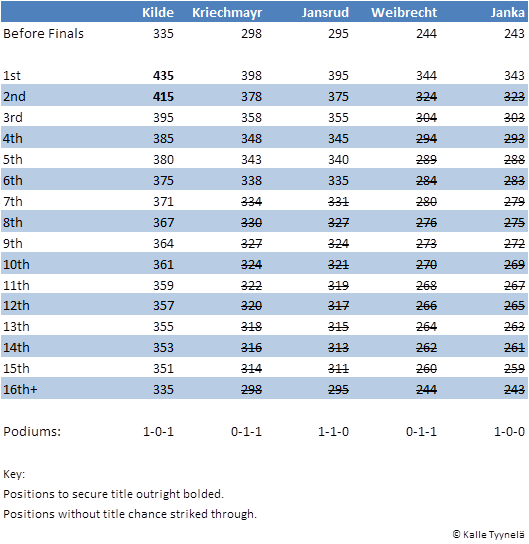
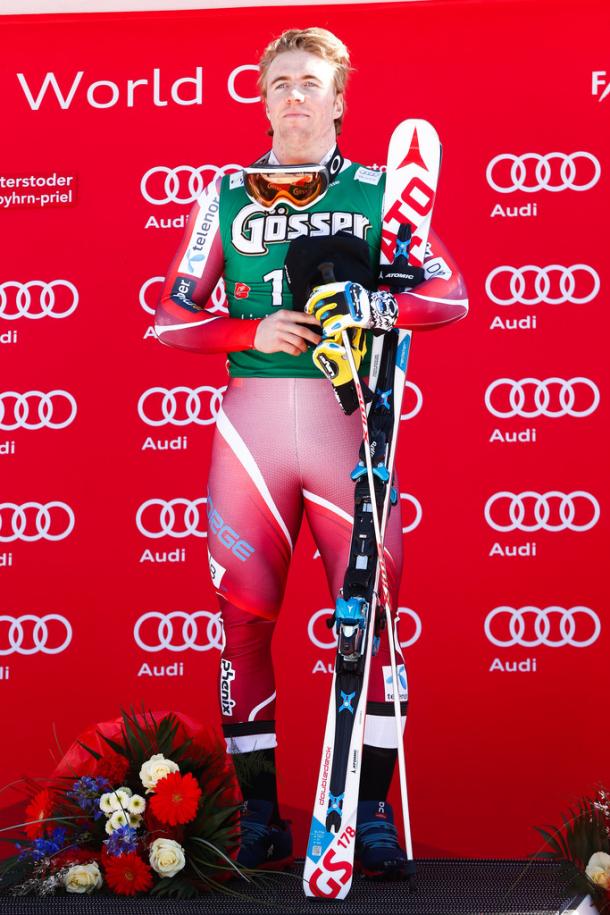
Kilde is having his breakthrough season on the World Cup tour, having achieved his first podium finishes and wins in super-G and downhill this season. Following Svindal’s injury, he’s become Norway’s lead contender for the super-G title. After winning in Hinterstoder, he came into the penultimate super-G of the season in Kvitfjell with a chance to secure the title, yet despite a decent fourth place, Jansrud with a win and Kriechmayr with a second place reduced the gap to keep the title open until the final race.
As we can see, a top-two finish is enough for Kilde for the title even if Kriechmayr or Jansrud won in St. Moritz. Yet the win in Hinterstoder is Kilde’s only top-two in super-G so far, with the third place of Val Gardena as his second-best result. Another breakthrough skier Kriechmayr, on the other hand, has never won a World Cup race in his career; if Kriechmayr (or Jansrud) finished second in St. Moritz, Kilde would need a top-five result for the title.
Like in downhill, Jansrud needs a great result in the final super-G to repeat the last season’s title. In super-G he has the better chance; if he won, he would need Kilde missing the top two and Kriechmayr not tying for the win. Or if Jansrud finished second, he would need Kilde missing the top five and Kriechmayr missing the top two. Even a sixth place would be enough for Jansrud (or Kriechmayr) for the title in the most unlikely scenario of Kilde missing the top 15, Kriechmayr (or Jansrud) missing the top six, and neither of Weibrecht or Janka winning the race.
The 30-year-old American Weibrecht is an Olympic silver and bronze medalist in super-G but had never finished on World Cup podium before the third place of the Beaver Creek and the second place of the Kitzbühel super-G races this season. To have a chance for the super-G title, Weibrecht would need his career-first win in St. Moritz. Another 1986-born, the 2010 overall World Cup champion Carlo Janka, had never won a World Cup super-G race before the Jeongseon weekend this season despite being a race winner in downhill and giant slalom as well as in alpine combined. Like for Weibrecht, the slim title chance would require a win in St. Moritz from Janka. Separated by only one point, the highly unlikely title scenario is similar for both Weibrecht and Janka; Kilde should miss the top 15 and both Kriechmayr and Jansrud should miss the top five.
Weather should play no role in the super-G title decider. Sunny conditions are forecasted for Thursday with the night temperature under -10 degrees centigrade ensuring a hard slope surface.
Men’s World Cup Finals Schedule
Wednesday, March 16
- 10:00 am local (5:00 am ET): Downhill
- Thursday, March 17
- 11:30 am local (6:30 am ET): Super-G
Friday, March 18
- 12:00 pm local (7:00 am ET): Mixed team competition
Saturday, March 19
- 9:30 am local (4:30 am ET): Giant slalom (first run)
- 12:00 pm local (7:00 am ET): Giant slalom (second run)
Sunday, March 20
- 8:30 am local (3:30 am ET): Slalom (first run)
- 11:00 am local (6:00 am ET): Slalom (second run)







